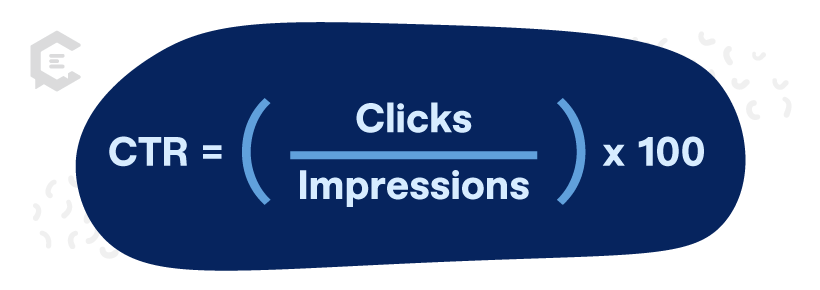What is a click-through rate (CTR)?
A click-through rate or CTR is a figure used to illustrate the ratio of how many people clicked on a web page compared to how many people saw the website. CTR is calculated by dividing the number of clicks on a link or ad by the number of impressions (or views) it received and then multiplying the result by 100 to get a percentage.
CTR = (Clicks / Impressions) x 100
For example, if an ad received 1,000 impressions and generated 50 clicks, the CTR would be (50/1,000) x 100 = 5%. This means that 5% of the users who viewed the ad clicked on it.
CTR is an important metric because it provides insights into the effectiveness of an ad or campaign. A higher CTR indicates that the ad is compelling to the target audience, while a lower CTR may suggest that the ad is not resonating. We can easily improve CTRs by creating more enticing ads, targeting the right audience, or refining our ad placement strategies.
Why is monitoring our click-through rates so important?
As marketers, our role and responsibility are to meet our goals. Though there are dozens of strategies across various mediums, we share one factor in common: the need to illustrate the return on investment. By monitoring our click-through rates, we can better determine the success of initiatives and campaigns.
Tracking click-through rates allows you to compare the performance of different pieces of content. This data will help you identify which topics, formats, or types of content generate more interest and engagement. After that, you can refine your content strategy, produce more of what works, and eliminate underperforming content.
With this percentage, you can also better understand how your words, responsive design choices, and promotion/sales strategy work for your client and their goals. Particularly in ad word campaigns and investments, you want to ensure you’re getting the most out of your assets and work, so calculating the CTR allows you to pivot if needed if something is falling short of expectations.
Common Uses of a Click-Through Rate:
- To calculate the success of a campaign
- To test different design and messaging strategies
- To test promotions, sales, and other call-to-actions (CTAs)
- To gather email addresses and subscribers
- To improve conversions and meet goals
Click-Through Rates Can be Misleading
In theory, a high click-through rate should mean everything is performing well, but sometimes, marketers can get caught up in the click-through rate without digging deeper into the analytics for the full story. It’s common sense but easy to forget: someone may click on a web page after seeing a promotion, but they may not take action.
A smart way to think about this is through sensational headlines or promotions: a user may be compelled to learn more, but once they do, they don’t become a customer, give their email address, or subscribe. Think about a ‘too-good-to-be-true’ free trip that makes you click, only to realize you must pay something outrageous to enter the drawing.
When someone clicks and bounces, it still counts toward your CTR percentage but isn’t beneficial to the company. That’s why conversions must also be part of your KPI strategy and analysis. These two data points are essential to meet goals and improve website performance.
What Are Some Ways Of Improving Click-Through Rates?
You can employ several real-world methods to improve your click-through rate and enhance the effectiveness of your content marketing efforts.
Compelling Headlines
Ensure you use attention-grabbing headlines that are concise, clear, and intriguing. You can do this by incorporating powerful words, posing questions, or highlighting the benefits to entice users to click and learn more. This tactic may only give you CTR data on your headline efficacy and might muddy your data regarding content engagement.
Relevant Meta Descriptions
A concise and compelling meta description will clarify to users that they have found the content they seek. Offering clarity always leads to more clicks.
A/B Testing
A/B testing multiple versions of headlines, meta descriptions, or CTA buttons is a fast and effective way to improve your click-through rates. If you continue to test variations in your content to see which ones generate higher CTRs, you’re all but guaranteed to make serious improvements.
Visual Appeal
Incorporate more visually appealing elements like images, videos, or infographics that catch users’ attention. Visual content can increase CTR by making your content stand out amongst the oversaturated pages on the internet.
Mobile Optimization
Ensure your content is optimized for mobile devices since an increasing number of users access content through smartphones and tablets. Mobile-friendly design, fast loading times, and easy navigation contribute to a positive user experience, increasing the likelihood of clicking through.
Optimize Content Placement
Consider the placement and visibility of your content. If you’re using advertising platforms, select optimal ad placements that reach your target audience effectively. Position high-value content on your website or blog in prominent locations to increase visibility and CTR.
Analyze and Learn
Regularly analyze your CTR data to identify trends, patterns, and areas for improvement.
Improve your click-through rate and get more sales with better ad copy from ClearVoice. Speak to a content specialist today to get started.






